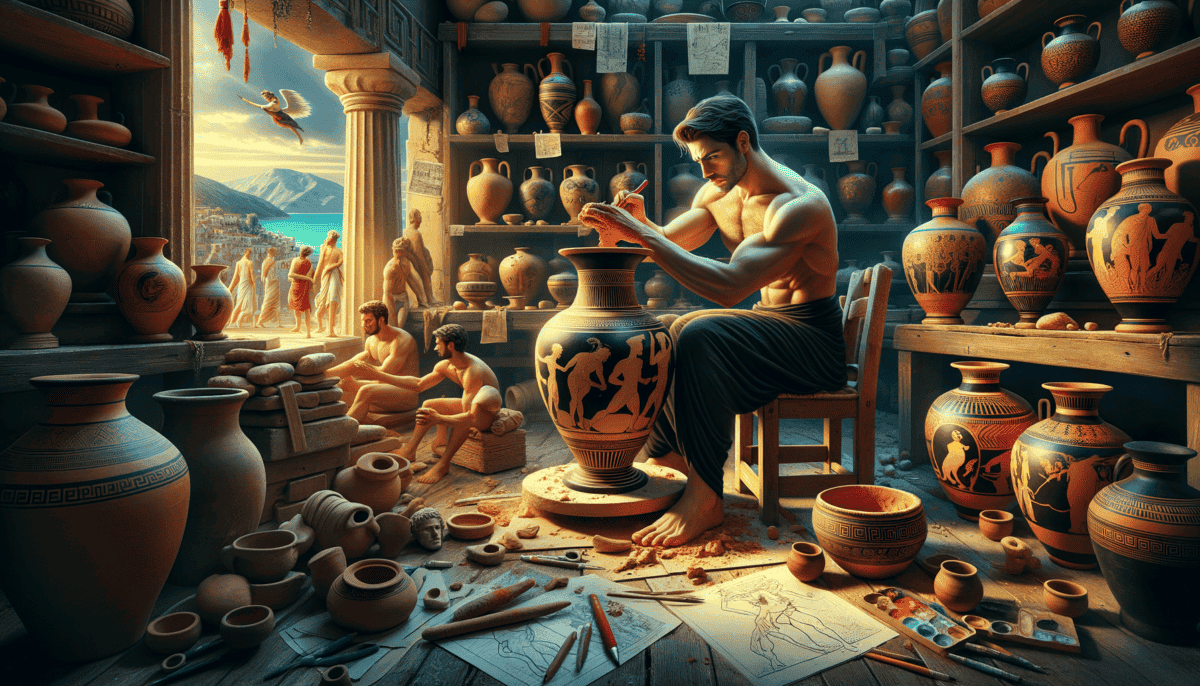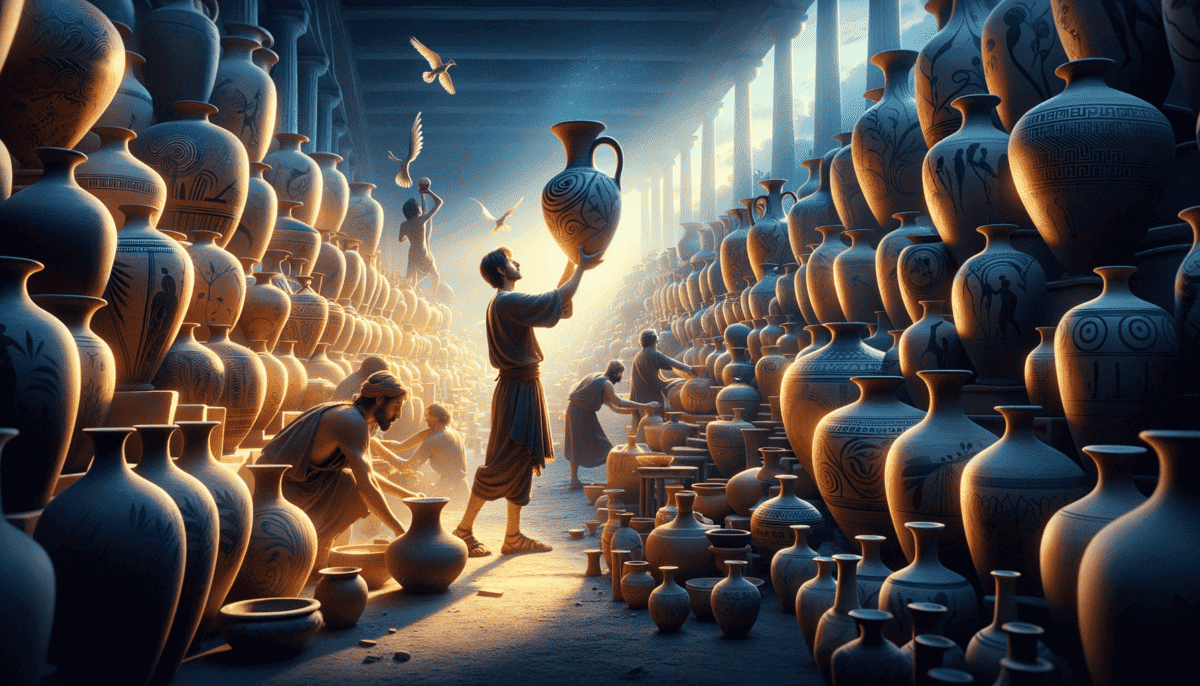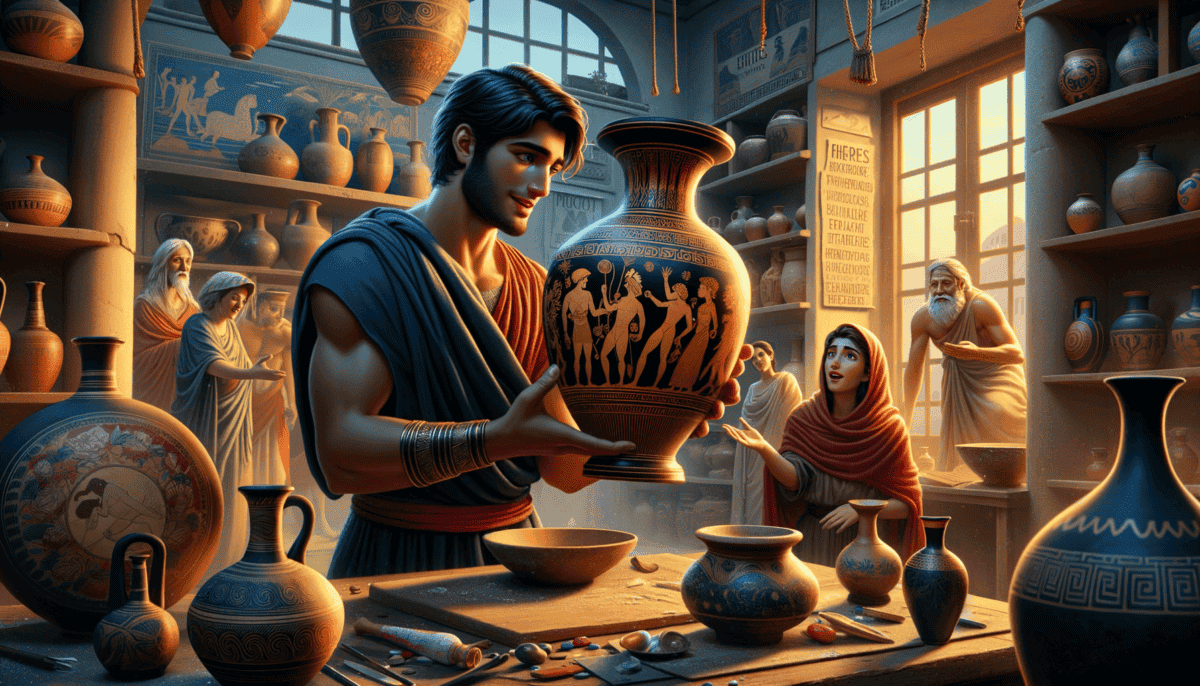The Clay Whispers
The sun was bright over Athens. Young Nikos walked through the busy market, his sandals kicking up dust. He was twelve years old and today was special. It was his first day as a pottery helper!
"Watch where you're going, boy!" shouted a fish seller as Nikos nearly bumped into his stand. The smell of fresh fish made his nose wrinkle.
Nikos hurried past colorful stalls filled with olives, bread, and cloth. His heart beat fast with excitement. He had always loved the pretty pots he saw in the market. Now he would learn to make them!
Finally, he reached the pottery shop. The building was small but neat, with clay pots of all sizes lined up outside. A woman stood in the doorway, her hands covered in wet clay.
"You must be Nikos," she said with a kind smile. "I am Sofia, your pottery master."
Sofia led him inside. The workshop was cool and dim. Clay pots were everywhere – on shelves, tables, and the floor. Some were plain brown, others painted with beautiful pictures.
"Come here," Sofia said, patting a wooden stool. She sat at a wheel and placed a lump of clay in the center. "Watch carefully."
Sofia's hands moved like magic. The clay spun and grew taller. Soon, a beautiful bowl appeared!
"Wow!" Nikos couldn't help saying. "How did you do that?"
Sofia laughed. "The clay speaks to us, Nikos. We just have to learn its language." She handed him a small piece of clay. "Here. Feel it."
The clay was cool and soft in his hands. Nikos squeezed it gently.
"This clay came from the river," Sofia explained. "People have been making pots here for hundreds of years. Each pot tells a story."
"What kind of stories?" Nikos asked, rolling the clay between his palms.
"Oh, all kinds! Stories of gods and heroes, of daily life, of things we want to remember forever." Sofia pointed to a large vase with pictures of warriors. "See? This one tells the story of a great battle."
• Clay from the river
• A spinning wheel
• Strong hands
• Lots of patience
Nikos looked at his small piece of clay. "Will I really learn to make beautiful pots like these?"
"Yes, but it takes time and practice. Are you ready to work hard?"
Nikos nodded eagerly. "I want to learn everything!"
"Then let's begin," Sofia said, handing him a bowl of water. "First, you must learn to prepare the clay properly."
As Nikos helped Sofia clean and sort clay that day, he knew this was just the beginning. His hands might be small now, but someday they would create beautiful pots that told amazing stories. The clay was whispering to him, and he couldn't wait to learn what it had to say.
The sun was setting when Sofia finally said it was time to go home. Nikos' arms were tired, but he was happy. Tomorrow would bring new lessons and more chances to learn the language of clay.
Hands of Tradition
Nikos arrived early at Sofia’s workshop the next morning. His hands were eager to touch the clay again.
“Good morning, young potter!” Sofia greeted him. “Today, we learn about different types of clay. Each one has its own special magic.”
Sofia led him to a corner where large clay bags sat. She picked up some reddish clay. “Feel this one,” she said.
“It feels rough!” Nikos said, running his fingers through it.
“Yes! This clay is perfect for big pots,” Sofia explained. She showed him a smooth, lighter-colored clay. “And this one is for making fine cups.”
Sofia demonstrated how to prepare the clay. “First, we remove tiny rocks,” she said, picking through the clay. “Then we add water to make it soft.”
Nikos watched as she mixed water with the clay. His eyes grew wide as it became smooth and stretchy. “It’s like making bread dough!” he said.
“Exactly!” Sofia laughed. “Now you try.”
Sofia's Teaching Tips for Clay:
- Feel the clay with your hands
- Add water slowly
- Mix it well
- Keep trying!
Nikos dipped his hands in water and started mixing his clay. Some splashed on his face, making Sofia smile.
“Don’t worry about the mess,” she said. “All good potters get dirty!”
After the clay was ready, Sofia showed him how to make a simple bowl. “Watch carefully,” she said, placing the clay on the wheel.
The wheel spun around and around. Sofia’s hands moved slowly, guiding the clay up. A small bowl began to form.
“Your turn,” she said, giving Nikos fresh clay.
Nikos sat at the wheel. His first try went wrong – the clay wobbled and fell over!
“Try again,” Sofia encouraged. “Keep your hands steady.”
On his third try, Nikos made something that looked almost like a bowl. It was a bit crooked, but Sofia beamed with pride.
“Well done!” she said. “Now you understand why we prepare the clay so carefully. Good clay makes good pots!”
As they worked, Sofia told him stories about pottery in Greece. “Our pots travel across the sea to other lands,” she said. “They carry olive oil, wine, and honey. But most importantly, they carry our stories.”
She pointed to a beautiful vase with pictures of people dancing. “See? This shows how we celebrate during festivals. When people far away see it, they learn about our life here.”
Nikos looked at his wobbly bowl with new eyes. Maybe someday, his pots would tell stories too!
That evening, Sofia let him take his first bowl home. “Practice with clay at home,” she said. “Let your hands remember its feel.”
Walking home, Nikos held his bowl carefully. His fingers were sore and his clothes were dirty, but he felt proud. He was learning the ancient art of pottery, one handful of clay at a time.
Black and Red – The Art of Storytelling
The morning sun lit up Sofia’s workshop as Nikos rushed in, excited to learn something new. Today was special – they would paint their first vases!
“Look at these,” Sofia said, showing two beautiful vases. One had black figures on red clay, the other had red figures on a black background.
“Wow!” Nikos gasped. “How did you make the figures different colors?”
Sofia picked up her brush. “Watch closely. First, we draw the outline.” Her steady hand traced a dancing figure on the vase.
“Can I try?” Nikos asked eagerly.
“Of course! Start with this practice pot.” Sofia handed him a small vase and a brush.
Nikos dipped his brush in the paint. His hand shook a little. “What should I draw?”
“Draw what you know,” Sofia smiled. “What did you see in the market yesterday?”
Nikos thought about the busy marketplace. He started drawing people buying fruits and vegetables. His first figures looked more like funny sticks with heads!
“Don’t worry,” Sofia laughed. “Keep practicing. Remember, every picture tells a story.”
• Hold your brush like a tiny sword
• Take deep breaths to keep your hand steady
• Look at the whole vase before you start
• Practice, practice, practice!
As days passed, Nikos got better at painting. His stick figures became real people. He learned to add small details – a basket of olives, a dog running, children playing.
“Now,” Sofia said one morning, “let’s try the black-figure technique.” She showed him how to paint the whole figure black, then scratch tiny lines to show details.
“It’s like making tiny roads in the paint!” Nikos said, carefully scratching lines for a horse’s mane.
Sofia nodded. “And for red-figure vases, we do the opposite. We paint everything around the figures black, leaving them red.”
Nikos loved both styles, but red-figure was his favorite. He could show more details in the faces and clothes.
One day, Sofia found him early in the workshop, painting carefully.
“What story are you telling today?” she asked.
Nikos stepped back proudly. On his vase, he had painted his own story – a young boy learning to make pottery. There was even a tiny Sofia teaching him!
“This is wonderful!” Sofia clapped. “You’re not just making pots anymore. You’re becoming a true storyteller.”
“Really?” Nikos beamed.
“Yes! Every mark you make, every figure you paint, helps keep our stories alive. Years from now, people will look at these vases and learn about how we lived.”
That night, as Nikos walked home, he looked at his paint-stained hands. They weren’t just potter’s hands anymore – they were storyteller’s hands too. Tomorrow, he would paint more stories, making sure each one was special.
The Panathenaic Challenge
The workshop buzzed with excitement. The Panathenaic Festival was coming! Every four years, Athens held this big celebration. The best potters would show their finest vases.
“Nikos,” Sofia called, her eyes bright. “I think you’re ready to enter the festival competition.”
Nikos’s heart jumped. “Me? Really?”
“Yes, you! Your storytelling through pottery has grown so much.”
“But what should I make?” Nikos asked, twisting his clay-stained apron.
Sofia placed a large piece of clay on his wheel. “Something that shows who you are. Something that tells your special story.”
Nikos sat at his wheel, thinking hard. His hands moved over the clay, but nothing felt right. The first pot was too wide. The second was crooked. The third collapsed!
“I can’t do it!” he said, dropping his head.
Sofia put her hand on his shoulder. “Take a walk. Look around our city. The right idea will come.”
Nikos walked through Athens’s busy streets. He saw:
• Children playing with toys
• Women carrying water jugs
• Men discussing in the marketplace
• Artists painting walls
• Musicians playing lyres
Suddenly, he knew what to make! He ran back to the workshop.
“I’ve got it!” he told Sofia. “I want to show how pottery brings people together!”
The vase grew tall and strong. Around it, Nikos painted scenes from the pottery workshop. He showed:
– People working together to make pots
– Teachers helping students
– Friends sharing stories while painting
– Families buying beautiful vases
“This is different,” Sofia said, watching him paint. “Most people paint gods and heroes.”
“But aren’t regular people heroes too?” Nikos asked. “Like you, teaching me everything you know?”
Sofia smiled proudly. “You’ve learned the most important lesson. Pottery isn’t just about making pretty things. It’s about showing what matters in life.”
Finally, the big day came. Nikos carried his vase to the festival grounds. His hands shook as he placed it on display.
People gathered around his vase. They pointed at the detailed scenes. Some smiled, recognizing themselves in the pictures.
“Look!” someone said. “This shows us – the real people of Athens!”
An old potter touched Nikos’s arm. “Young man, you’ve captured the heart of our craft. It’s not about the clay or the paint. It’s about bringing people together.”
Nikos stood taller. Win or lose, he knew he had made something special. His vase told the story of his city, his people, and his love for pottery.
That evening, as the judges walked around, Nikos held Sofia’s hand. They both knew that no matter what happened, a new chapter in Nikos’s journey had begun. His vase would tell its story for years to come.
Ships and Stories
The morning sun sparkled on the waters of Piraeus, Athens’s busy port. Nikos watched big ships carrying vases to faraway places.
“Each pot tells our story to the world,” Sofia said, standing beside him.
Nikos’s eyes grew wide. “How far do our vases travel?”
A merchant named Marcus approached their workshop. He wore colorful clothes from distant lands.
“I’ve come from Rome,” Marcus said. “People there love Greek pottery. They want to buy your vases!”
Sofia nudged Nikos forward. “Show him your festival vase.”
Marcus studied the vase carefully. His face lit up. “This is exactly what I’m looking for! The people in Rome will love seeing how Greeks live.”
“Really?” Nikos beamed. “You want to buy my vase?”
“Not just one,” Marcus smiled. “I want ten more just like it!”
While he worked, Sofia taught him about trading:
“Our vases are worth more than just money. They share our stories, our art, and our way of life with people everywhere.”
One morning, a group of children visited the workshop. Nikos showed them how he packed the vases carefully in straw.
“Where will they go?” a little girl asked.
Nikos pulled out a map. “These vases will sail across this big sea. People in Rome will use them in their homes. They’ll learn about us through our art.”
The children gathered around as Nikos painted his last vase. He added new details:
• Ships sailing on waves
• Traders from different lands
• Children playing games
• Families sharing meals
“You’re not just a potter anymore,” Sofia said proudly. “You’re a storyteller for the whole world.”
Finally, loading day arrived. Nikos helped carry his vases to Marcus’s ship. Each one was wrapped carefully.
“These will make many people happy,” Marcus said, paying Sofia a bag of silver coins.
Sofia handed most of the coins to Nikos. “Your first big sale! You’ve earned this.”
Nikos watched the ship sail away. His pots would soon be in homes far across the sea. People would eat from them, drink from them, and learn about life in Athens.
“What’s next?” he asked Sofia.
She pointed to her worktable. “There’s always another story to tell, another pot to make. Are you ready?”
Nikos rolled up his sleeves. His hands were eager to shape more clay, to tell more stories, to reach more people across the vast Mediterranean world.
The Final Masterpiece
The morning light streamed through the workshop windows. Nikos stood before his worktable, facing his biggest challenge yet.
“Today,” Sofia announced, “you will create your masterpiece – a vase that tells your own story.”
Nikos’s hands trembled with excitement as he shaped the clay. This wasn’t just another pot. This was his journey.
“Remember when you first came here?” Sofia smiled. “You could barely center the clay!”
Nikos laughed. “And now look at me!” His hands moved confidently, the wheel spinning smoothly.
As he worked, memories flowed into the clay:
“Each curve represents a lesson learned. Each line tells a story of growth.”
The vase grew taller, its shape perfect and strong. Around its surface, Nikos painted scenes from his journey:
• His first day as an apprentice
• Learning to use the wheel
• Making his festival vase
• Trading with distant lands
• Teaching younger students
“Look how he blends the red and black figures,” someone whispered. “Just like the old masters!”
Sofia watched proudly as Nikos added the finishing touches. The vase showed not just skill, but heart.
“It’s time for the firing,” Sofia announced. Everyone held their breath as the vase went into the kiln.
The next morning, Nikos carefully opened the kiln. His vase stood perfect and gleaming.
“It’s beautiful!” the crowd gasped.
Marcus stepped forward. “This belongs in the finest home in Rome!”
But Sofia shook her head. “No, this one stays here. It will inspire new apprentices for years to come.”
She turned to Nikos with shining eyes. “You are no longer my student. You are now a master potter.”
Nikos looked around the workshop – his home, his school, his world. Young apprentices watched him with admiring eyes, just as he once watched Sofia.
“Will you teach us?” a small boy asked.
Nikos smiled, remembering his own first day. “Of course! There are so many stories yet to tell, so many pots yet to make.”
He picked up a fresh ball of clay and gestured for the children to gather round. As his hands began to shape the clay, he knew this wasn’t an ending – it was a new beginning.
The ancient art of pottery would live on, carrying stories across time and sea, connecting people through beauty and craft, one masterpiece at a time. ✨






